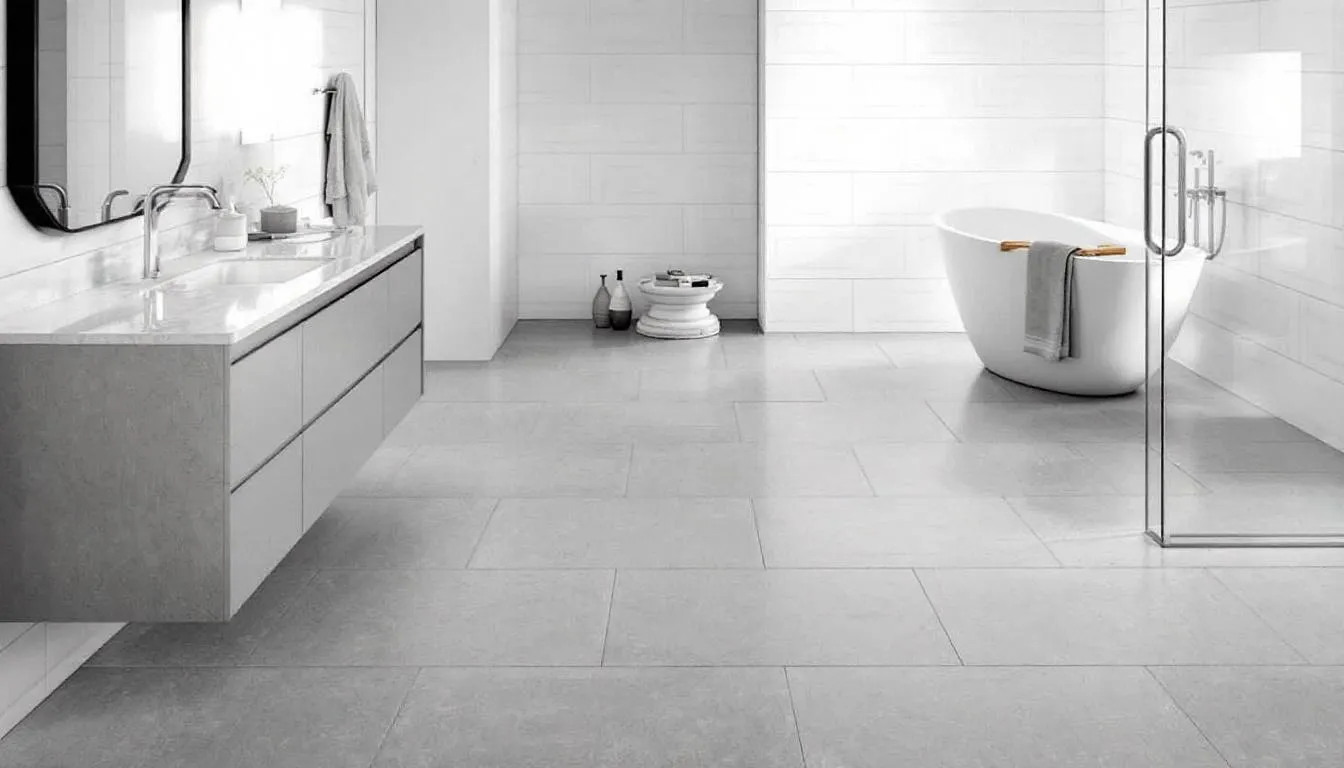How to Choose Tiles for Bathroom: A Complete Guide
by Gregory
August 14, 2025

Key Takeaways
- Set a clear budget and pick durable, low-maintenance tiles like porcelain or ceramic for wet areas.
- Limit your tile choices to three types and stick to a 2-3 color palette to keep the look cohesive.
- Prioritize slip resistance for floor tiles and water resistance for shower areas to keep things safe.
- Use light-colored tiles to make small bathrooms feel more spacious; dark tiles add a cozy vibe in well-lit rooms.
- Think about maintenance—natural stone needs sealing, while glazed ceramic is easier to care for.
Choosing bathroom tiles can feel overwhelming with so many options out there. Whether you are undertaking a complete condo interior renovation or simply updating your bathroom, this guide will help you find the perfect balance between style, durability, and budget so you end up with a bathroom that’s both beautiful and built to last.
Setting Your Budget and Planning
Getting your budget right is the first step to picking the perfect bathroom tiles. Many people focus only on the tile cost and forget about installation and other materials, which can add up to 30-50% more. If your renovation includes refinishing floors, consider hiring top-rated floor refinishing services to ensure a seamless and high-quality finish that complements your new tiles.
Budget Breakdown
Think about the cost of tiles, professional installation, tools, and add a 10% buffer for cuts and any unexpected repairs. Porcelain tiles usually cost between $3-10 per square foot, ceramic tiles $2-7, and natural stone can be $7-20 or more. Don’t forget to budget for grout, waterproofing, and trim, which usually add $2-5 per square foot.
Smart Allocation
Spend more on high-traffic or wet areas like shower floors—porcelain tiles are great here because they’re durable and slip-resistant. You can save money by using ceramic tiles on the walls. Also, consider buying tile samples ($5-15 each) so you can see how they look with your lighting and fixtures before making a big commitment.
Understanding Bathroom Tile Materials
The material you choose affects how your bathroom functions and how much maintenance you’ll need.
Ceramic Tiles
Ceramic tiles are versatile and budget-friendly, perfect for walls and floors that don’t get too much wear. Glazed ceramic tiles resist water and clean easily but aren’t as durable or dense as porcelain, so they’re not the best choice for shower floors.
Porcelain Tiles
Porcelain tiles are dense, non-porous, and highly water-resistant, making them ideal for shower walls and floors. They can mimic luxury materials like wood or stone and have fewer grout lines, which means less cleaning. Though a bit pricier than ceramic, porcelain is a smart long-term investment because it lasts longer and requires less upkeep.
Natural Stone Tiles
Natural stone tiles like marble, slate, and limestone bring a timeless, elegant look and unique character to your bathroom. Each tile has its own beautiful veining, so no two are alike. They’re great for heated floors, adding warmth and luxury.
But keep in mind, natural stone needs regular sealing every 1-3 years to protect against stains and moisture. Because they’re porous, they require more care and a higher installation budget.
Mosaic and Specialty Tiles
Small mosaic tiles are perfect for creating intricate tile patterns and offer excellent slip resistance thanks to their many grout lines. Glass mosaics add brightness and shine to shower niches and accent walls.
Pre-mounted sheets make installation easier, and penny tiles provide great grip on shower floors. Specialty tiles, like metal accents or textured ceramics, can create stunning feature walls but might be trickier to clean or less comfortable to walk on barefoot.
Choosing the Right Tile Size and Layout
The size of your tiles can change the whole feel and function of your bathroom. Large format tiles (12×24 inches or bigger) have fewer grout lines, which makes small bathrooms look bigger and keeps cleaning easier. They do require careful installation to avoid uneven edges.
Classic subway tiles (3×6 inches) and medium sized tiles (6×6 to 12×12 inches) are versatile and easy to work with, supporting popular patterns like herringbone without overwhelming the space.
Small or large tiles work well in wet areas where slip resistance and drainage are important. They fit nicely on sloped floors but need more grout maintenance. Despite the extra cleaning, their safety benefits make them worth it.
Color Selection and Design Coordination
The colors you pick set the mood and can even change how big your bathroom feels. Light-colored tiles like white, cream, and pale gray reflect light, making small bathrooms feel more open and airy. White subway tile is a timeless favorite that fits many styles.
Darker tiles in navy, charcoal, or black add a rich, cozy feel to larger, well-lit bathrooms and help hide water spots. But keep in mind, dark grout can make cleaning a bit trickier.
Stick to a palette of three coordinating colors to keep things from looking too busy. Pick a standout tile as your focal point, then choose other tiles that complement it. Think about how your tile colors will work with your fixtures and lighting for a polished, cohesive bathroom design.
Safety and Functionality Considerations
Safety is key, so choose textured tiles or matte finish tiles with good slip resistance for floors and shower areas. Glossy tiles look great on walls but can be slippery underfoot.
Balance slip resistance with comfort—heavily textured tiles might feel uncomfortable barefoot. Heated floors are a cozy bonus in colder climates, especially with natural stone or porcelain.
Smaller tiles fit better on sloped floors, helping water drain properly, while large tiles can sometimes cause pooling. Plan your layout to direct water toward drains and keep your bathroom safe and dry.
Grout Selection and Maintenance Planning
Grout impacts both the look and upkeep of your bathroom. Picking the right grout and maintenance routine can save you time and hassle.
Grout Color Strategy
Light grout looks fresh but shows stains easily and needs frequent cleaning. Dark grout hides dirt well but can mask buildup over time.
Grout Material Options
Epoxy grout is stain-resistant and durable—great for showers but a bit pricey. Cement grout is cheaper and works fine if you seal and maintain it properly.
Grout Maintenance Planning
Seal grout annually to keep moisture and mildew at bay. Thin grout lines look sleek but need careful installation; wider lines are easier to clean.
Installation and Professional Consultation
Good installation is key to beautiful, long-lasting tiles and avoiding costly repairs. Know when to hire a pro or tackle it yourself.
Measurement and Material Planning
Measure your space carefully and order 10-15% extra tiles for cuts and mistakes. Store tiles flat and dry to prevent damage.
Professional vs. DIY Considerations
Hire professionals for tricky jobs like natural stone or waterproofing. DIY works for simple ceramic tile projects if you prepare properly.
Installation Sequence Planning
Install wall tiles first, then floors, to protect finished work. Make sure there’s proper waterproofing behind shower tiles and tub walls to avoid damage.
Common Mistakes to Avoid
Avoid using porous natural stone in showers without sealing—it needs ongoing care. Glossy tiles look great on walls but can be slippery on floors.
Stick to how many different tiles you use, limiting to three tile types max to keep your design cohesive and avoid visual chaos. Test your tile colors under your bathroom’s lighting before buying to make sure they look right.
Think about long-term tile maintenance and installation costs, not just the initial price, to avoid surprises down the road.
FAQ
What’s the most durable tile for bathroom showers?
Porcelain tiles are water-resistant, tough, and low-maintenance—perfect for shower walls and floors.
How do I calculate how many tiles I need?
Measure the surface area (length x width), add 10-15% for waste and cuts, and subtract areas for doors and fixtures.
Can I mix different tile materials in one bathroom?
Yes! Just keep it to three types max for a cohesive look. Popular combos include porcelain floors, ceramic walls, and glass mosaic accent tiles.
What tile size works best for small bathrooms?
Large format tiles (12×24 inches or bigger) with fewer grout lines help small bathrooms feel bigger. Medium sized tiles (6×12 inches) balance space and practicality.
How often should bathroom tiles be resealed?
Natural stone needs resealing every 1-3 years; grout should be sealed annually to keep moisture and mildew out.
What's Your Reaction?
Excited
0
Happy
0
In Love
0
Not Sure
0
Silly
0
Gregory
Gregory is a website manager who loves reading books, learning languages and traveling. He's always been fascinated by different cultures, and has spent years studying different languages in order to be able to communicate with people from all over the world. When he's not working or traveling, he enjoys relaxing at home with a good book.


